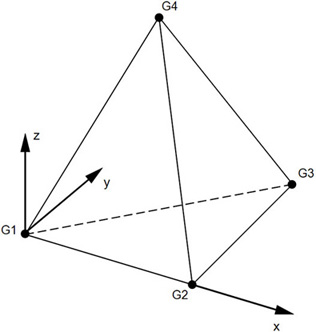Four-Sided Solid Element Connection
Description: Defines the connections of a four-sided isoparametric solid element with four to ten grid points.
Format:

Example:

| Field | Definition | Type | Default |
|---|---|---|---|
| EID | Element identification number. | Integer > 0 | Required |
| PID | Property identification number of a PSOLID entry. | Integer > 0 | Required |
| Gi | Grid point identification numbers of connection points. | Integer ≥ 0 or blank, all unique | Required |
Remarks:
- Element identification numbers must be unique with respect to all other element identification numbers.
- The topology of the diagram must be preserved; i.e., G1, G2, G3 define a triangular face G1, G8, and G4 are on the same edge, etc.
- Any or all of the edge points, G5 through G10, may be deleted. If the ID of any edge connection points is left blank or set to zero (as for G8 and G9 in the example), the element equations are modified to give the correct results for the reduced number of connections. Corner grid points cannot be deleted.
- Components of stress are output in the volume coordinate system. (See the VOLUME command in Section 3, Case Control.)
- It is recommended that the edge grid points be located within the middle third of the edge.
- The element coordinate system is defined as follows:
The origin is located at G1 and the x-axis lies on the G1-G2 edge. The y-axis lies in the G1-G2-G3 plane and is perpendicular to the x-axis. The positive y-axis lies on the same side of the G1-G2 edge as node G3. The z-axis is orthogonal to the x and y axes.

Figure 1. CTETRA Element Connection

Figure 2. CTETRA Element Coordinate System